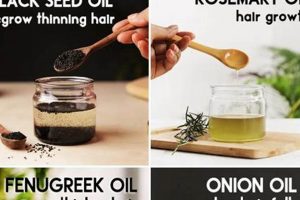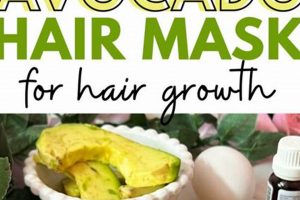The subject matter pertains to creating intensive hair treatments at home, utilizing readily available ingredients. These treatments aim to deeply nourish and hydrate hair, addressing concerns such as dryness, damage, and lack of luster. A common example involves combining ingredients like coconut oil, honey, and avocado to formulate a moisturizing mask.
The practice offers several advantages, including cost-effectiveness, control over ingredients, and the ability to customize formulations to specific hair needs. Historically, homemade hair remedies have been a tradition passed down through generations, evolving alongside advancements in ingredient knowledge and cosmetic science. The core benefit lies in providing a personalized and often more natural alternative to commercially produced conditioners.
The following sections will detail specific recipes, application techniques, and considerations for various hair types to maximize the effectiveness of such treatments. This will allow for a more comprehensive understanding and practical application of at-home hair conditioning practices.
Tips for Effective DIY Deep Hair Conditioning
The following tips outline best practices for maximizing the benefits and minimizing potential drawbacks of homemade deep hair treatments. Adherence to these recommendations will contribute to healthier and more manageable hair.
Tip 1: Select Ingredients Based on Hair Type: Different hair types require different ingredients. Oily hair benefits from lighter oils like grapeseed oil, while dry hair benefits from richer oils like coconut or olive oil. Understand the specific needs of the hair before selecting ingredients.
Tip 2: Conduct a Strand Test: Prior to applying the treatment to the entire head, test a small, inconspicuous strand of hair. This helps identify potential allergic reactions or undesirable effects on color-treated hair. Observe the strand for 24 hours before proceeding.
Tip 3: Apply to Clean, Damp Hair: For optimal absorption, apply the treatment to clean, damp hair. Excess oil or styling product buildup can hinder the penetration of the conditioning ingredients. Towel-dry hair gently to remove excess water.
Tip 4: Use Heat for Enhanced Penetration: Applying gentle heat can enhance the penetration of the treatment into the hair shaft. Use a warm towel, a hair steamer, or a hooded dryer for approximately 15-30 minutes.
Tip 5: Rinse Thoroughly: Ensure thorough rinsing to remove all traces of the treatment. Residue can weigh down the hair and attract dirt. Use lukewarm water and consider a final rinse with cool water to seal the cuticle.
Tip 6: Limit Frequency of Application: Overuse of deep conditioning treatments can lead to product buildup and potentially weaken the hair. A frequency of once or twice per month is generally sufficient for most hair types.
Tip 7: Consider Ingredient Freshness: Use fresh, high-quality ingredients. Avoid using spoiled or expired ingredients, as these can irritate the scalp or harbor bacteria. Store homemade treatments properly to maintain their efficacy.
Employing these tips optimizes the potential benefits of homemade deep conditioning treatments, resulting in healthier, more hydrated, and more resilient hair. Careful planning and execution are essential for achieving desired results.
The subsequent sections will explore common concerns and troubleshooting strategies associated with at-home hair treatments.
1. Ingredient Selection
Ingredient selection forms the foundation of any effective homemade deep hair conditioning treatment. The efficacy of these treatments is directly correlated with the appropriateness and quality of the chosen ingredients. This selection process necessitates a clear understanding of hair type, condition, and desired outcome.
- Oils and Butters
Oils and butters provide emollient and occlusive properties, contributing to hair hydration and shine. Coconut oil, olive oil, shea butter, and avocado oil are common choices. Their varying molecular weights and fatty acid profiles dictate their suitability for different hair porosities. For example, coconut oil, with its smaller molecular structure, penetrates the hair shaft more readily, making it effective for low porosity hair, while heavier oils are better suited for high porosity hair.
- Humectants
Humectants attract and retain moisture, drawing it from the environment into the hair shaft. Honey, glycerin, and aloe vera are frequently incorporated. The concentration of humectants must be carefully considered, as excessive use can lead to hygral fatigue or frizz, especially in humid climates. The effectiveness of humectants is also dependent on ambient humidity levels; in dry environments, they may draw moisture from the hair, exacerbating dryness.
- Proteins
Proteins strengthen and repair damaged hair, filling in gaps in the cuticle. Hydrolyzed proteins, such as keratin or silk amino acids, are often used. Overuse of protein treatments can lead to stiffness and breakage, a condition known as protein overload. Balancing protein treatments with moisturizing treatments is crucial for maintaining hair elasticity and preventing damage.
- Botanical Extracts and Additives
Botanical extracts and additives offer specific benefits, such as scalp stimulation, anti-inflammatory properties, or enhanced shine. Examples include tea tree oil, known for its antifungal properties, and apple cider vinegar, used to balance pH. It is imperative to consider potential sensitivities or allergies before incorporating these ingredients into a homemade formulation.
Careful consideration of these facets ensures that the ingredients chosen align with the specific needs of the hair, ultimately maximizing the effectiveness of DIY deep hair conditioning and minimizing the risk of adverse reactions or undesirable outcomes. The deliberate and informed selection of components allows for a personalized and targeted approach to hair care, promoting overall hair health and vitality. The effectiveness is maximized with the right ingredients selection and preparation
2. Proper Application
The efficacy of any homemade deep hair conditioner is inextricably linked to its proper application. Improper application negates the potential benefits of even the most carefully selected ingredients, resulting in suboptimal outcomes. The process of distributing the conditioning treatment throughout the hair, from root to tip, significantly impacts the extent to which the hair shaft receives the intended nourishment and hydration. For instance, uneven application may lead to some sections of the hair remaining dry and brittle while others become overloaded with product, creating an imbalance in moisture levels.
Several factors contribute to proper application. These include preparing the hair adequately (e.g., washing and towel-drying), dividing the hair into manageable sections for even distribution, and employing application techniques that ensure thorough coverage, such as using a wide-tooth comb to detangle and distribute the product. Furthermore, the ambient temperature and the use of heat, such as a warm towel or steamer, can influence the penetration of the conditioner into the hair cuticle. A real-world example involves individuals with thick hair who often neglect the inner layers during application, resulting in a superficial conditioning effect. Proper technique, including sectioning and saturation, mitigates this issue.
In conclusion, proper application is not merely a supplementary step but an integral component of a successful homemade deep conditioning regimen. The effectiveness hinges on meticulous attention to detail, encompassing preparation, distribution, and environmental factors. By understanding and implementing appropriate application techniques, individuals can maximize the potential benefits of DIY deep hair conditioners, achieving healthier, more hydrated, and more manageable hair. Failure to apply the conditioner correctly directly affects the benefit.
3. Treatment Duration
Treatment duration, with respect to homemade deep hair conditioning, represents a critical variable influencing the outcome of the process. This parameter directly impacts the extent to which conditioning agents penetrate the hair shaft and exert their intended effect. Insufficient exposure time limits the absorption of beneficial components, leading to a less-than-optimal conditioning result. Conversely, excessive treatment duration, while seemingly innocuous, can potentially lead to undesirable consequences, such as hygral fatigue or protein overload, depending on the specific ingredients employed. The duration, therefore, requires careful consideration, balancing the need for adequate penetration with the risk of overexposure.
The appropriate treatment duration is contingent upon several factors, including hair type, porosity, and the specific formulation of the homemade conditioner. For instance, individuals with high-porosity hair, characterized by a more permeable cuticle, may benefit from shorter treatment durations, as their hair readily absorbs moisture. Conversely, low-porosity hair, with a tighter cuticle, may require extended exposure to facilitate ingredient penetration. A practical example involves using a DIY deep conditioner containing honey; leaving it on for an extended period may attract excessive moisture, causing the hair to become overly soft and prone to breakage, especially in humid environments. Conversely, a protein-based treatment left on for too long could make the hair feel stiff.
In summation, treatment duration is a fundamental aspect of homemade deep hair conditioning, requiring careful calibration based on individual hair characteristics and ingredient composition. Balancing this parameter ensures that the hair receives adequate nourishment without incurring potential damage from overexposure. Understanding this connection is vital for achieving optimal results and maintaining hair health within the context of DIY practices. The time is the key to balancing the ingredients on to the hair.
4. Rinsing Technique
Effective rinsing constitutes a pivotal phase in homemade deep hair conditioning, directly impacting the residual effects and overall outcome of the treatment. Proper removal of product residue prevents undesirable consequences such as product buildup, scalp irritation, and diminished hair manageability.
- Water Temperature
Water temperature plays a critical role in the rinsing process. Lukewarm water is generally recommended as it effectively removes product without overly stripping the hair of its natural oils. Hot water can dehydrate the hair, leading to frizz and damage. Conversely, cold water may not effectively dissolve and remove the conditioning agents, particularly oils and butters. For example, rinsing a coconut oil-based deep conditioner with cold water may leave a greasy residue. The selection of lukewarm water is a balance between effective product removal and preservation of hair moisture.
- Rinsing Duration and Thoroughness
The duration and thoroughness of rinsing are crucial for complete product removal. Insufficient rinsing can result in product accumulation on the scalp and hair shaft, leading to a heavy, greasy feel and potentially clogging hair follicles. The rinsing process should continue until the water runs clear, indicating that all traces of the conditioner have been removed. For instance, individuals with thick or long hair may require significantly more rinsing time to ensure thoroughness. An inadequate rinsing will lead to product buildup.
- Final Rinse Additives
The addition of specific ingredients to the final rinse can enhance the conditioning process. Apple cider vinegar, diluted with water, can help to balance the pH of the scalp and hair, resulting in increased shine and reduced frizz. Herbal infusions, such as chamomile or rosemary, can provide additional benefits, such as soothing the scalp or promoting hair growth. However, the selection of final rinse additives should be based on individual hair needs and sensitivities. A properly prepared apple cider vinegar rinse promotes hair shine.
- Conditioner Emulsification Prior to Rinsing
Emulsifying the deep conditioner with a small amount of water before rinsing can facilitate its removal. This process helps to break down the product and allows it to rinse away more easily. This is particularly beneficial for thicker or oil-based conditioners. Failure to emulsify can result in residue, even with prolonged rinsing. Adding a small amount of water helps breakdown ingredients and easy to rinse.
The connection between rinsing technique and the effectiveness of homemade deep hair conditioners underscores the importance of meticulous attention to detail in the hair care process. Proper rinsing ensures that the benefits of the conditioner are fully realized, without the adverse effects of product buildup or improper removal. Therefore, the rinsing step should be considered an integral component of the overall conditioning treatment, deserving of as much consideration as ingredient selection and application. Improper rinsing removes the benefits of the conditioner and leaves a oily residue.
5. Hair Type
Hair type serves as a foundational consideration in the formulation and application of homemade deep hair conditioning treatments. The inherent characteristics of each hair typeranging from fine and oily to thick and drydictate the specific needs and sensitivities that must be addressed to achieve optimal results. For example, a deep conditioner formulated for dry, coarse hair may prove overly heavy and cause buildup on fine, oily hair, leading to a lackluster appearance and potential scalp irritation. Conversely, a lightweight conditioner designed for oily hair may lack the necessary emollient properties to effectively hydrate and repair dry, damaged strands. A clear understanding of one’s hair type is therefore paramount to selecting appropriate ingredients and application techniques for DIY treatments. Neglecting to account for hair type can lead to ineffective treatments and potential damage.
The classification of hair type commonly incorporates factors such as hair texture (fine, medium, coarse), porosity (low, medium, high), and curl pattern (straight, wavy, curly, coily). Each of these characteristics influences the way hair responds to different ingredients and treatments. For instance, high-porosity hair, characterized by a more open cuticle, readily absorbs moisture but also loses it quickly, necessitating ingredients with strong occlusive properties to seal in hydration. Low-porosity hair, on the other hand, requires lighter, smaller-molecule ingredients that can penetrate the tightly closed cuticle. A real-world example might involve an individual with fine, low-porosity hair using a deep conditioner rich in heavy oils like shea butter, only to find that the hair becomes weighed down and greasy despite being dry. The texture, density, porosity, and curl pattern of hair significantly influences the effects of deep conditioning.
In summary, the connection between hair type and DIY deep hair conditioner is one of cause and effect; hair type dictates the appropriate composition and application of the treatment, and the treatment, when properly matched, produces the desired outcome of healthy, hydrated hair. Challenges arise when individuals misidentify their hair type or fail to adjust their treatments accordingly, leading to frustration and potential damage. Therefore, a foundational understanding of hair characteristics is essential for navigating the world of homemade hair care and achieving successful, customized deep conditioning treatments. Matching treatments with appropriate hair types directly impacts effectiveness.
Frequently Asked Questions
This section addresses common inquiries regarding the formulation, application, and expected outcomes of homemade deep hair conditioning treatments.
Question 1: What are the primary benefits of utilizing homemade deep hair conditioners compared to commercially available products?
Homemade formulations offer greater control over ingredients, allowing for the avoidance of potentially harmful chemicals and customization to specific hair needs. They also tend to be more cost-effective.
Question 2: How frequently should one apply a homemade deep hair conditioner?
The optimal frequency depends on hair type and condition, but generally, once or twice a month is sufficient. Overuse can lead to product buildup and potential weakening of the hair.
Question 3: Can homemade deep hair conditioners be used on color-treated hair?
Yes, but caution is advised. Certain ingredients, such as lemon juice or apple cider vinegar, may affect hair color. A strand test is recommended prior to full application.
Question 4: What are the potential risks associated with using homemade deep hair conditioners?
Risks include allergic reactions to ingredients, ingredient interactions that may damage the hair, and scalp irritation from improper formulations. Thorough research and patch testing are crucial preventative measures.
Question 5: How does one determine the appropriate ingredients for their specific hair type?
Understanding hair porosity, texture, and moisture levels is essential. Fine hair benefits from lightweight oils, while coarse hair may require richer ingredients. Researching specific ingredients and their effects on different hair types is recommended.
Question 6: What is the proper storage method for homemade deep hair conditioners?
Homemade formulations should be stored in airtight containers in a cool, dark place to prevent spoilage and maintain their efficacy. Refrigeration may be necessary for certain formulations.
In conclusion, while DIY deep hair conditioners offer numerous benefits, responsible formulation and application are paramount. Careful consideration of ingredients, hair type, and potential risks is essential for achieving desired results and maintaining hair health.
The subsequent section will present a collection of proven recipes for common hair care needs.
Conclusion
The preceding discussion has illuminated the multifaceted nature of DIY deep hair conditioner. The effective utilization of these treatments necessitates careful consideration of hair type, ingredient selection, application technique, treatment duration, and rinsing protocol. Adherence to these guidelines optimizes the potential benefits, minimizing the risk of adverse outcomes.
The practice represents a cost-effective and customizable alternative to commercial products, empowering individuals to tailor their hair care regimens to specific needs. Continuous research and diligent application of established best practices will further refine the effectiveness of DIY deep hair conditioning, contributing to improved hair health and manageability.







